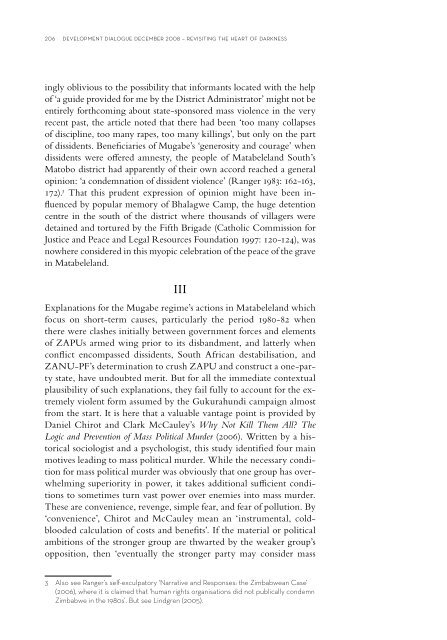60 years after the UN Convention - Dag Hammarskjöld Foundation
60 years after the UN Convention - Dag Hammarskjöld Foundation
60 years after the UN Convention - Dag Hammarskjöld Foundation
You also want an ePaper? Increase the reach of your titles
YUMPU automatically turns print PDFs into web optimized ePapers that Google loves.
206 development dialogue december 2008 – revisiting <strong>the</strong> heart of darkness<br />
ingly oblivious to <strong>the</strong> possibility that informants located with <strong>the</strong> help<br />
of ‘a guide provided for me by <strong>the</strong> District Administrator’ might not be<br />
entirely forthcoming about state-sponsored mass violence in <strong>the</strong> very<br />
recent past, <strong>the</strong> article noted that <strong>the</strong>re had been ‘too many collapses<br />
of discipline, too many rapes, too many killings’, but only on <strong>the</strong> part<br />
of dissidents. Benefi ciaries of Mugabe’s ‘generosity and courage’ when<br />
dissidents were off ered amnesty, <strong>the</strong> people of Matabeleland South’s<br />
Matobo district had apparently of <strong>the</strong>ir own accord reached a general<br />
opinion: ‘a condemnation of dissident violence’ (Ranger 1983: 162-163,<br />
172). 3 That this prudent expression of opinion might have been infl<br />
uenced by popular memory of Bhalagwe Camp, <strong>the</strong> huge detention<br />
centre in <strong>the</strong> south of <strong>the</strong> district where thousands of villagers were<br />
detained and tortured by <strong>the</strong> Fifth Brigade (Catholic Commission for<br />
Justice and Peace and Legal Resources <strong>Foundation</strong> 1997: 120-124), was<br />
nowhere considered in this myopic celebration of <strong>the</strong> peace of <strong>the</strong> grave<br />
in Matabeleland.<br />
III<br />
Explanations for <strong>the</strong> Mugabe regime’s actions in Matabeleland which<br />
focus on short-term causes, particularly <strong>the</strong> period 1980-82 when<br />
<strong>the</strong>re were clashes initially between government forces and elements<br />
of ZAPUs armed wing prior to its disbandment, and latterly when<br />
confl ict encompassed dissidents, South African destabilisation, and<br />
ZANU-PF’s determination to crush ZAPU and construct a one-party<br />
state, have undoubted merit. But for all <strong>the</strong> immediate contextual<br />
plausibility of such explanations, <strong>the</strong>y fail fully to account for <strong>the</strong> extremely<br />
violent form assumed by <strong>the</strong> Gukurahundi campaign almost<br />
from <strong>the</strong> start. It is here that a valuable vantage point is provided by<br />
Daniel Chirot and Clark McCauley’s Why Not Kill Them All? The<br />
Logic and Prevention of Mass Political Murder (2006). Written by a historical<br />
sociologist and a psychologist, this study identifi ed four main<br />
motives leading to mass political murder. While <strong>the</strong> necessary condition<br />
for mass political murder was obviously that one group has overwhelming<br />
superiority in power, it takes additional suffi cient conditions<br />
to sometimes turn vast power over enemies into mass murder.<br />
These are convenience, revenge, simple fear, and fear of pollution. By<br />
‘convenience’, Chirot and McCauley mean an ‘instrumental, coldblooded<br />
calculation of costs and benefi ts’. If <strong>the</strong> material or political<br />
ambitions of <strong>the</strong> stronger group are thwarted by <strong>the</strong> weaker group’s<br />
opposition, <strong>the</strong>n ‘eventually <strong>the</strong> stronger party may consider mass<br />
3 Also see Ranger’s self-exculpatory ‘Narrative and Responses: <strong>the</strong> Zimbabwean Case’<br />
(2006), where it is claimed that ‘human rights organisations did not publically condemn<br />
Zimbabwe in <strong>the</strong> 1980s’. But see Lindgren (2005).

















